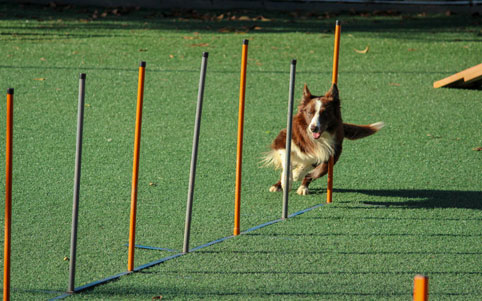If you’ve decided to start your own dog training business, odds are that you either have an existing dog-focused business, like grooming or doggy day care, and training is a natural addition for you, or you’ve decided on dog training as a relatively low-cost business to start a career in.
So what do you need to make your dog training business a success?
1. Get qualified
Most people who want to become dog trainers have trained their own pets, and likely a few of their friends pooches as well. That experience is going to be vital, because you’ll be dealing with a variety of dogs. Different breeds have different temperaments, and what works well when training one dog can fail badly with another.
There are a ton of courses that can prepare you based on different models of training – the field of dog training is continuously evolving and depending on what discipline and methods resonate with you will affect the route you pursue.
Although a certification isn’t mandatory, it does help in setting yourself up as a true professional and gives dog owners confidence in your abilities.
To earn a respected title with the Certification Council for Professional Dog Trainers, you’ll need to complete a minimum of 300 hours of experience in training dogs within three years and pass a 180-question exam. The Association of Pet Dog Trainers also has information on dog training education and certifications.
How much does it cost to become a dog trainer?
Depending on what type of training you pursue will affect the amount you pay for a course. There are free and paid options depending on the formality of the approach. From online training resources, in person sessions, and accreditation, the decision is yours. You can spend upwards of $1500 for a program to receive a certificate or choose to be uncertified. Keep in mind that to establish a customer base and keep attracting customers, you’ll need to prove that your experience and methods really do work.
An alternative option is to become an apprentice. Working as an intern or apprentice can give you crucial experience with a variety of other trainers without breaking the bank. Plus you can get a well-rounded approach that lets you gain exposure to different training methods and disciplines.
Improve your people skills
A surprisingly large amount of dog training also involves training the owner. You’re going to need empathy and great conversational skills so that you can explain things to dog parents without upsetting them. Training a dog once a week is great, but that dog spends the rest of its time with its human – and a human that doesn’t understand the training process is going to undo all of your hard work in the days between training sessions.

3. Create a business plan
As with any business, small or large, you’ll want at least a basic business plan.
Your overheads may be low, but it’s still a good idea to get everything down on paper before you get too caught up in the excitement of starting something new.
If this is your first business, make sure you look at every possible cost. From qualifying courses to insurance, add each of these in and budget for them. Lay out an achievable timeline for your goals, and create check lists of what needs to be done before you start advertising your services.
4. Insurance is vital – find the right coverage
Working with animals means a certain amount of unpredictability. Add a varied mix of dogs and humans in close proximity and accidents can happen. Finding the right dog training insurance with adequate coverage is vital to protecting yourself and your business.
There are two main types of insurance a dog trainer will want: public liability, which covers your legal liabilities to third party claims, and professional indemnity, which protects your business against client claims for loss or damage.
If you employ someone or have a volunteer working with you, you’ll need employer’s liability insurance as a legal requirement which applies to any business, no matter how large or small.
5. Specialize to increase your customer base
Basic training like puppy socialization, leash training, and basic manners are all likely to bring you clients looking for those introductory skills. However, to have dog owners return to you, you’ll want to vary what types of classes you offer – from trick training to advanced obedience, agility or scent work.
Depending on what type of schedule you’re offering you can have a calendar of different classes for different levels and then add follow-up courses for those that have enjoyed the consistency and success of working with you.
6. Upskill to become a dog behaviorist
Dog trainers teach the dogs to obey a set of commands. A dog behaviorist deals with the psychological behavior of an animal. This is the expert people go to when Fido starts acting strangely, tries to bite the mailman, or starts self-destruction behaviors. Dogs, like humans, can have a massive range of emotional problems that need help including separation anxiety and food aggression - two big areas that behaviorists see a lot of.
7. Create a website
Word of mouth is the greatest form of advertisement and provided you have happy clients, you should start to pick up referrals. But, you’ll need a website to go along with that, since most people will search for you before they ever contact you directly.
Starting a website that shows your calendar, courses, hours and markets your accreditation can help limit the amount of questions you receive. Setting up easy contact and registration forms can cut back on admin time, meaning you get more time to spend leveling up your skills or teaching.
8. Get social
Social media is a must, even for a small business. Find out where your average client is like to spend most of their online time, and make sure you have a business account in that space. Whether you’re on Instagram, Facebook, Twitter, or TikTok, regular posts and cute updates build word of mouth and a fanbase, plus they show your dedication and expertise.
If you’re starting up in a new area, join local Facebook groups to post about introductory offers and start to form partnerships with local related businesses. Maybe you can host a meet-up for dog owners at a local pet store, or organize a walk at a park. The more active you become on social media within your area, the more visibility you’ll gain for your business.
If you’ve already started a pet-related business, make sure you let your customers know about the new training options for their fur baby, and add it to your website. Offer promotions and referral discounts, and if you have a newsletter, make sure your new dog training business is front and center for signed up customers to see on your next email, with a reminder every couple of months.
Once you’ve established a good relationship with local kennels and groomers, make sure to let them know you’re available. You can offer to work with them on courses, and doggy day-care is an ideal situation for in-house training on basic commands. It’s often a good idea to advertise with local veterinarians as well, since that is often the first place customers go when they get a new dog.

9. Be flexible and reliable
As a dog trainer, be prepared to work evenings and weekends, when the humans are available for the training sessions. You’ll need to decide whether you want to work on one-to-one or group basis or both, and how big any group is going to be.
Once you’ve committed to a day and time, make sure you turn up promptly. If you have an unavoidable personal emergency that means you won’t make it that week, make sure to notify your clients immediately.
10. Charge reasonably for your area
Do research on existing trainers in your area to get a good idea of what a reasonable charge per session is. Undercutting or overcharging are both going to do more harm than good; aim for a happy medium in price. As you gain experience and a good reputation, you can adjust your prices to match.
You should also adjust your prices for different specialties. For example, a puppy training class is usually cheaper than an advanced agility training session.
With the right preparation, you can become a certified dog trainer and set up a business to bring in happy customers. If dog training isn’t your ideal pet business, consider looking into starting a pet sitting service or setting up dog kennels instead.